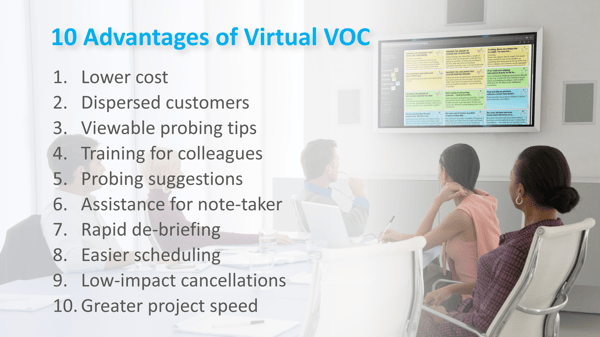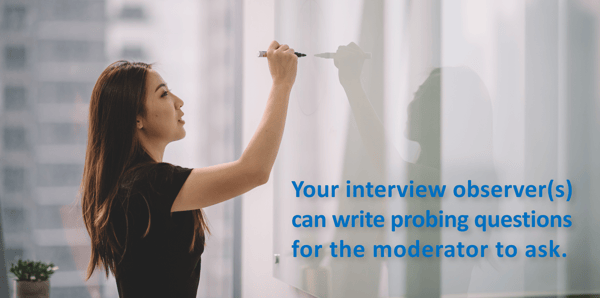10 Advantages of virtual VOC (web-conference) interviews over in-person voice-of-customer.
Face-to-face customer interviews are the "gold standard" of voice-of-customer interviews. Want to observe body language and non-verbal cues? You should have an in-person meeting. Looking to build customer relationships? Better get on a plane. Want a tour of your customer’s facility? Don’t ask them to strap on a GoPro camera for you. That said, there are some important--and oft-overlooked--advantages of virtual VOC over in-person VOC. Consider 10:

Advantage 1: Lower cost. This is the most obvious advantage. Imagine you send 2-3 interviewers out on 6-10 qualitative and 6-10 quantitative interviews. You could easily spend $50,000 on travel expenses, and that’s just for domestic travel. Also consider that you’ve probably consumed a total of 2-3 person-months of employee time, with a least 80% of it spent in rental cars, security lines and cramped airplane seats. All these travel expenses and wasted personnel time go away with virtual VOC.
Advantage 2: Dispersed customers: Virtual VOC is ideal if your customer’s R&D staff is in Houston, its marketing is based in Chicago, and so on. This is helpful for qualitative Discovery interviews, because you should interview multiple customers simultaneously, so they can build off each other’s ideas. For quantitative Preference interviews, it’s even more important to engage all decision-influencers at the same time. Why? Imagine the operations manager rates the importance of abrasion resistance at “3” and the marketing person gives it a “9.” If you gathered their results individually, you’d have to average their responses at “6”… a terrible idea. But in a virtual session with all present, you can let them debate, and finally resolve their function-specific viewpoints with this simple question: “From the perspective of your entire company, how important is abrasion resistance?”
Advantage 3: Viewable probing Tips: The key to great VOC is great probing. With the “What and Why” method of probing, the moderator asks “what” questions, such as "When does this happen?" Then she asks “when” questions, like “How does this impact you?” Before moving to the next customer outcome (“What other problems are you seeing?”), the moderator asks, “Anything else we should know before we move on?” Here’s the advantage of virtual VOC over in-person VOC: You can set these tips in front of you during the interview and constantly refer to them. Yes, you could do this in a face-to-face interview, but it’s much smoother doing this on a web-conference when customers can’t see you checking tips in front of you. You'll find these tips in your BlueTool, Discovery Interview Quick-Start Card at www.blueprintingcenter.com > BlueTools > Conduct Discovery Interviews / Tours.

Advantage 4: Training for colleagues: What if you need some employees trained in B2B VOC? Wouldn’t it be cool if they could observe real VOC interviews… without travel costs… without taking much time… without disrupting the interview dynamics? Virtual VOC comes through again. Introduce them at the beginning of the interview—no one should ever eavesdrop—and then let them observe the interview. They can easily do this in a conference room with the rest of the interview team or from their own office.
Advantage 5: Probing suggestions: If your interview team is meeting in a conference room together, make sure it has a whiteboard or flipchart. And maybe have two observers (instead of one) supporting the moderator and note-taker. As the observers think of probing questions the moderator has missed, they write them on the whiteboard, making sure to also record the number of the sticky note. Then your absolutely-brilliant-sounding moderator can say the customer, “You know, I had another question about something you said on note number 7 regarding shorter training time.”

Advantage 6: Assistance for note-taker: We’ve noticed something peculiar about in-person interviewing: Customers sometimes forget about the poor note-taker. Because they’re personally engaged with the moderator and observer, they don’t look at the projection screen and notice the note-taker is falling behind. The dynamics change with virtual VOC. Since the only thing customer can watch is the web-conference screen, they immediately notice any lagging note-taking. We find customers are more helpful in slowing their pace, repeating points, and suggesting text changes.
Advantage 7: Rapid debriefing: After an in-person interview, the team should go to a nearby coffee shop or airport lounge and debrief: Picture the team gathered at Starbucks with the observer recommending additions and changes as the note-taker makes them in the appropriate sticky notes. The Ebbinghaus Forgetting Curve suggests we forget half of what we’ve learned in the first 24 hours. With virtual VOC, the debriefing can begin immediately after the interview. No hunting for a place to speak openly, setting up the laptop again, worrying about catching flights, etc.
Advantage 8: Easier scheduling: Sometimes the hardest part of B2B VOC is scheduling the interview. The issue usually boils down to availability and reluctance, and virtual VOC helps with both. The availability of your team can be dicey if all three of you need the same open travel day that the customer is available. But it’s easier finding a time when you’re all available for a 1-to-2 hour virtual interview. And if some customer contacts are traveling, they can be included remotely as well. What about customer “reluctance”? Would you rather have a traveling salesman come to your home or call you on the phone? OK, that’s a bad analogy, but you get the idea. Some customers will feel OK giving up an hour or even two, if they know they can say at the end of the allotted time, “Well, I need to head off to another meeting now.”
Advantage 9: Low-impact cancellations: Face it, you will likely have some cancelled customer interviews. Your main contact got sick, they just had a business emergency, their CEO called an all-hands meeting, their conference room was taken over by a VP… or they simply messed up their calendars. With virtual VOC, you don’t need to limp back to the airport empty-handed at the end of a wasted day. You simply reschedule.
Advantage 10: Greater project speed: We saved our favorite for last. If your new product eventually has annual sales of $5 million with average profits, can you guess the net present value of accelerating the launch by one month? $80,000. That’s $4,000 NPV per business day, so speed matters! Virtual VOC lets you move faster with more productive scheduling (see Advantage #8), and the ability to schedule two or more interviews per day. Converting many of your in-person interviews to virtual VOC can easily take a month or two off your timeline.
For more on this topic, see e-Learning Module 20: Remote Interviews, at www.blueprintingcenter.com > e-Learning.
Keywords: remote interview, virtual VOC, virtual voice of customer, web-conference interview, video-conference interview, desktop sharing, customer interview, interview training, customers at multiple locations
